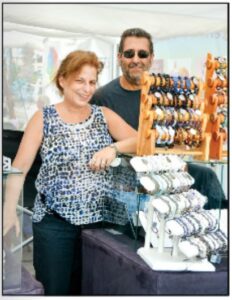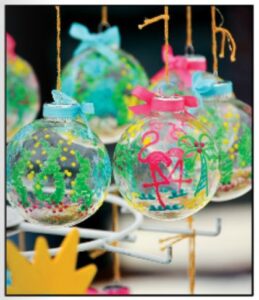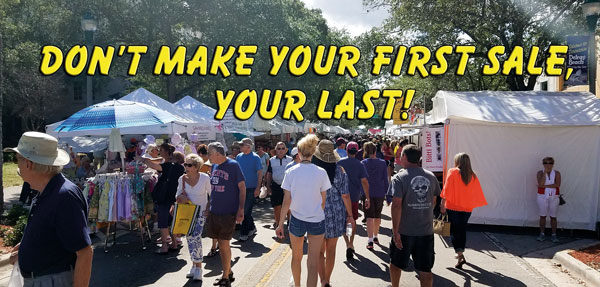
Over the last year since we’ve emphasized our online presence so much I’ve been reading like crazy about all the different social media, mass email systems, transactional email, how to maintain contact with customers and deliver meaningful information (because of course that’s our business) and all kinds of other “technological” innovations that allow us to be in touch with you! We’re always trying to come up with better ideas and more effective ways to do business so I try to read just about everything I can on the subject. I just finished reading another article entitled “Email Workflows You Should Be Using in Your Marketing Automation.” Of course some of this stuff just goes way over my head. But in the end it made me realize that no matter the “technical” engine you put behind your marketing and sales efforts… it’s really just the same old thing!
As I write this article, the fall season is just around the corner and there is no time that is more important for us to sharpen our selling skills than when we’re in a position to come face to face with more customers than any other time of the year. For quite a few people this time of year is when we take in about 50% or better of all the money we make all year long so if there was ever a time to maximize your sales… this is it! I’ll provide you some of my thoughts on the subject.
At one point in my life I was involved in sales training. And as such, I became very well versed in most of the techniques involved in selling. All these are great… but one thing I learned was that 90% of all sales are made when you just simply stick to the basics of selling… Let the customer know you exist… tell them what you do… show them how they can benefit by owning your work… and ask for the order. So whether you’re selling paintings or pottery… sculpture or salsa… dolls or dresses… it really makes no difference. The process or getting your work into the hands of your customers is just about the same.
 Let the customer know you exist. No one can buy from you if they don’t know about you. I believe this is the marketing phase of selling. It’s a program designed to raise awareness of the product you offer. This can be accomplished by attending and exhibiting at events like we list here in our guide. It can be a result of an internet website. You could hand out flyers or talk up what you’re doing among friends. Home parties have worked well for Tupperware and it’s become a household word. You could advertise in a newspaper, magazine, on TV or maybe even the radio. You may choose an email blast targeted to a specific group most interested in your kind of product. Some people produce seminars or workshops where they demonstrate the product they are selling. There are a million different ways to “get the word out” and let people know about you. However you do it, the marketing of your work is a very important part of what you must do to sell. This is only the first step in the process though and if this is all the further you’re willing to go then you’ll probably be heading home with just about everything you came with!
Let the customer know you exist. No one can buy from you if they don’t know about you. I believe this is the marketing phase of selling. It’s a program designed to raise awareness of the product you offer. This can be accomplished by attending and exhibiting at events like we list here in our guide. It can be a result of an internet website. You could hand out flyers or talk up what you’re doing among friends. Home parties have worked well for Tupperware and it’s become a household word. You could advertise in a newspaper, magazine, on TV or maybe even the radio. You may choose an email blast targeted to a specific group most interested in your kind of product. Some people produce seminars or workshops where they demonstrate the product they are selling. There are a million different ways to “get the word out” and let people know about you. However you do it, the marketing of your work is a very important part of what you must do to sell. This is only the first step in the process though and if this is all the further you’re willing to go then you’ll probably be heading home with just about everything you came with!
Tell your story. The unique nature of what we create makes what we offer special. And that special quality is what separates our work from some mass merchandised piece you may buy at Wal-Mart or Home Depot or maybe the Old Time Pottery Store. Just like you, I’ve seen offerings very similar to what we see exhibited at shows… at a fraction of the price in a big box store. So telling your story… how you came up with the concept… how it was created… what was the thought process behind it… is essential to helping the customer understand they are buying a unique work of art and they won’t see it at the next ten homes they visit! Do you remember the Home Interiors parties back in the late 70’s and early 80’s? That was the ultimate vision of mass marketed interior decorating! Every home you visited had just about the same thing. It didn’t look bad for the time… but talk about nothing unique. You can be the antithesis of this type of trend… and luckily it went out of vogue. But if you shop any of today’s chain store like “Rooms to Go” or “Kane Furniture” you’ll see they are still trying to relive the glory days of mass design.
 So how do you tell your story? What makes your work distinct? How do you interact with the customer to let them know? Well part of that starts with you. It’s worth taking a little time to analyze your thoughts and organize them into a cohesive story that’s easy to follow. You can even rehearse it with some willing participants. Initially you could even write a script (that may later become a notecard you place with the piece). For some people this comes naturally… for most, it’s a learned skill. After you get a little more relaxed with the presentation it will come naturally but notes, rehearsal, role playing and the like will get you headed down the right path.
So how do you tell your story? What makes your work distinct? How do you interact with the customer to let them know? Well part of that starts with you. It’s worth taking a little time to analyze your thoughts and organize them into a cohesive story that’s easy to follow. You can even rehearse it with some willing participants. Initially you could even write a script (that may later become a notecard you place with the piece). For some people this comes naturally… for most, it’s a learned skill. After you get a little more relaxed with the presentation it will come naturally but notes, rehearsal, role playing and the like will get you headed down the right path.
Show them the benefits. Even though the customer may never tell you… the most important question they have is “What’s in it for me?” This is where you have to put yourself in the customer’s shoes and try to look at the sale from their point of view. How do we do that? To begin with, lets ask them some questions and find out a bit about their life and the things they consider important… the kind of decor they like… the kind of things they own already… what are their favorite colors… their favorite artists… do they have a large home, a small apartment or a mobile home for example. The more you know about them, the better you can make a meaningful recommendation. Clearly the extent to which you go with this is somewhat reflective of the price point of the item you’re selling. If for example you’re selling PVC marshmellow shooters for $6.00 each then the extent of the question might be “Do you have kids or grandchildren?” If not… most likely that’s the end of the sales pitch. But if you’re selling an original sculpture at $10,000 then it’s worth taking a couple of hours of fact finding! In the end the question is still the same… “What benefit does the customer get by owning your work?” They have to want your work more than they want their money! Let them touch the work… maybe try it out… get them to picture themselves owning the piece. Play on peer pressure by having them consider how jealous the neighbors or their friends will be. Have them picture the spot in their house where the piece will reside. Maybe you can use the status they will enjoy. It all depends on what you’re selling. The better you can answer that question, and the better you become at reading your prospective customers then the more successful you’ll become at selling your product!
 Ask for the order. OK… this is the close! This is the step where they actually give you’re the money and you actually give them the work. How do we do this… we’ll there are lots of ways… some more direct than others! As simple as this sounds… and as logical as it is… you would be shocked at how many people do absolutely everything correct to this point, but don’t have the nerve to actually ask for the money! They’ve done the presentation. They’ve done fact finding about the customer. They’ve answered questions and overcame objections. The customer is on the verge of pulling out their wallet and the exhibitors says something like… “Well think about it and let me know.” Or worse… he says nothing at all to motivate the customer to move forward with the sale! I’ve watched thousands of exhibitors sell… I’ve seen this kind of thing happen over and over again. They go home with dismal sales while some guy a few booths down the row can’t find time to count his money! What’s the difference? ASK FOR THE ORDER!
Ask for the order. OK… this is the close! This is the step where they actually give you’re the money and you actually give them the work. How do we do this… we’ll there are lots of ways… some more direct than others! As simple as this sounds… and as logical as it is… you would be shocked at how many people do absolutely everything correct to this point, but don’t have the nerve to actually ask for the money! They’ve done the presentation. They’ve done fact finding about the customer. They’ve answered questions and overcame objections. The customer is on the verge of pulling out their wallet and the exhibitors says something like… “Well think about it and let me know.” Or worse… he says nothing at all to motivate the customer to move forward with the sale! I’ve watched thousands of exhibitors sell… I’ve seen this kind of thing happen over and over again. They go home with dismal sales while some guy a few booths down the row can’t find time to count his money! What’s the difference? ASK FOR THE ORDER!
That request can be something as simple as “Will that be cash or would you rather write a check?” It can be assumptive… “Would you like to take it home right now or would you like to pay for it now and pick it up later? Other times you may ask for the order and you’ll get an objection. If that’s the case, you’ll have to revert back to the “Show them the benefits” phase of the sale and reenforce the points that got them to this part of the sale. Here again… the better the job you’ve done to this point, the easier this will be.
If you still get some objection, you will have to also instill a “sense of urgency” so they make the buying decision today. The world is full of “be backs” and “I want to think about it” types. The reality is that even thought they may be seriously considering the purchase, once they walk out of your booth the chances of the sale actually happening drop to only a small fraction of what they are when you’ve got them there with the check book ready! I used to tell people… “A lot of people tell me they want to think about it… really they want to forget about it! But when they get home and someone else bought the work… or I’ve packed it up in the truck… they are sorry they didn’t have it at home!” The truth is… this is a one time opportunity. You won’t be making another one just like it. You’ll be gone in a couple of hours and with your departure also goes the opportunity for them to make this work theirs! Make sure they know that!
 Sometimes you’ll get the price objection. Mostly this isn’t actually true… most likely what they are looking for is an excuse to buy. You may not want to ever concede on price. But chances are if you don’t sell to this person now you never will. NEVER give a huge discount in the initial negotiation! In fact, rather than a discount, sometimes it’s better to give added value. That way it supports your price structure and if you have another customer considering a similar purchase you don’t run the risk of having to discount that sale too! If you sell pottery and they buy a set of coffee mugs… you could for example throw in a sugar bowl. If you sell prints, you could discount the frame by 25%. If you do have to change the price, don’t ever offer more than just a very small discount initially. This sets the whole pace of the negotiation and more or less defines the value of your work. If it were a $100.00 piece I might discount say $5.00 and make it $95.00. You’d be surprised at just how many people will go ahead and buy. In a substantial number of cases the discount isn’t really the issue. It’s the principal attached to the success of negotiation. Or it’s that “little excuse” that gives them the reason to buy now. It’s all really more a “mind game” than anything else… after all. If $5.00 really makes that much difference in the purchase… or $25.00 for that matter… what the heck are they even doing here! They need to be spending their money on food and housing… not on art! Well that’s about it. Everyone has a built in fear of sales to start with. When you stop to think about it what is that fear anyway? After all… who is afraid to take money and see happy customers walk away with their work? No one I know! The fear of sales is really the fear of rejection and especially when you’ve conceived the work yourself, created it with your hands, put your personal expression into it… and sometimes you’ve laid your soul bare to present it… you’re bound to take it personally if someone doesn’t like it! Well the reality is that the art or craft we create is unique. And there is absolutely nothing “objective” about a personal creation. To some we’re a creative genius… to others we are out of our minds and all out taste is in our mouth… it’s just the nature of the beast. If you’re going to sell art or craft, then you must develop a thick skin and divorce yourself from the very emotion that allowed you to create the work in the first place. Get elated when people love what you make… and learn to accept that some people just have really bad taste!!! In any case… keep in mind the basics. Let the customer know you exist… tell them what you do… show them how they can benefit by owning your work… and ask for the order. These simple steps will serve you better than all the fancy sales techniques and closes you’ll ever study!
Sometimes you’ll get the price objection. Mostly this isn’t actually true… most likely what they are looking for is an excuse to buy. You may not want to ever concede on price. But chances are if you don’t sell to this person now you never will. NEVER give a huge discount in the initial negotiation! In fact, rather than a discount, sometimes it’s better to give added value. That way it supports your price structure and if you have another customer considering a similar purchase you don’t run the risk of having to discount that sale too! If you sell pottery and they buy a set of coffee mugs… you could for example throw in a sugar bowl. If you sell prints, you could discount the frame by 25%. If you do have to change the price, don’t ever offer more than just a very small discount initially. This sets the whole pace of the negotiation and more or less defines the value of your work. If it were a $100.00 piece I might discount say $5.00 and make it $95.00. You’d be surprised at just how many people will go ahead and buy. In a substantial number of cases the discount isn’t really the issue. It’s the principal attached to the success of negotiation. Or it’s that “little excuse” that gives them the reason to buy now. It’s all really more a “mind game” than anything else… after all. If $5.00 really makes that much difference in the purchase… or $25.00 for that matter… what the heck are they even doing here! They need to be spending their money on food and housing… not on art! Well that’s about it. Everyone has a built in fear of sales to start with. When you stop to think about it what is that fear anyway? After all… who is afraid to take money and see happy customers walk away with their work? No one I know! The fear of sales is really the fear of rejection and especially when you’ve conceived the work yourself, created it with your hands, put your personal expression into it… and sometimes you’ve laid your soul bare to present it… you’re bound to take it personally if someone doesn’t like it! Well the reality is that the art or craft we create is unique. And there is absolutely nothing “objective” about a personal creation. To some we’re a creative genius… to others we are out of our minds and all out taste is in our mouth… it’s just the nature of the beast. If you’re going to sell art or craft, then you must develop a thick skin and divorce yourself from the very emotion that allowed you to create the work in the first place. Get elated when people love what you make… and learn to accept that some people just have really bad taste!!! In any case… keep in mind the basics. Let the customer know you exist… tell them what you do… show them how they can benefit by owning your work… and ask for the order. These simple steps will serve you better than all the fancy sales techniques and closes you’ll ever study!


